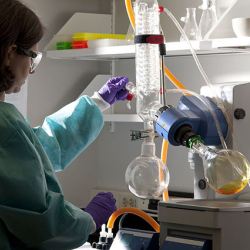The advances in medical practice since World War II have been stunning, and they continue apace. Here, I anticipate some that I think are likely to make significant contributions in the near future.

Part 1 discussed some of the advances already in existence. Here are my guesses about some medical breakthroughs that are imminent.
New antibiotics to treat antibiotic-resistant infections
Antibiotics have been with us for more than a century, but the miracles of the modern antibiotic era are usually considered to date from the availability of highly purified penicillin in the 1940s. Microorganisms are crafty, however, and they have developed many mechanisms to defeat the drugs designed to kill them. That means they can continue to grow and damage their host. Resistant infections can be difficult, and sometimes impossible, to treat.
Antimicrobial resistance is an urgent global public health threat. In the U.S., more than 3 million antibiotic-resistant infections occur each year, and more than 48,000 Americans die as a result, according to the CDC.
Research on new antibiotics has been largely stagnant in recent years, perhaps because, to slow the spread of microbial resistance to the drugs, physicians wisely have been discouraged from unnecessarily prescribing antibiotics, so the demand for them has decreased.
A member of a new class of antibiotics, a macrocyclic peptide called zosurabalpin, has shown promising results against Carbapenem-resistant Acinetobacter baumannii (CRAB), a Gram-negative bacterium considered an urgent threat by the U.S. CDC and the World Health Organization. Carbapenems are broad-spectrum antibiotics that are effective against numerous types of bacteria, including those resistant to many other antibiotics and are usually reserved for known or suspected multidrug-resistant (MDR) bacterial infections.
Zosurabalpin works by trapping lipopolysaccharide (LPS), a component of the bacterium’s outer membrane, by inhibiting a protein complex called the LptB2FGC complex, which results in the death of the bacterium. It was discovered after researchers examined approximately 45,000 macrocyclic peptides and found them to be effective against more than 100 CRAB clinical samples tested in the lab and multiple mouse infection models.
This breakthrough comes at a time when the FDA has not approved any new classes of antibiotics for harmful Gram-negative bacteria in more than 50 years, and treatment options for CRAB infections are dwindling while mortality rates rise.
Further research and clinical trials will be needed to fully understand the potential of this new antibiotic and its congeners and to study their possible side effects.
Another promising finding on the antibiotics front was reported in an article in the journal Nature in December. It described a class of antibiotics that can kill methicillin-resistant Staphylococcus aureus (MRSA), which causes more than 10,000 deaths in the U.S. yearly. None of the compounds has yet been tested in clinical trials, but they kill bacteria in vitro and in two mouse models of MRSA infection. They also show very low toxicity against human cells. The compounds were identified using deep learning -- a new name for an old approach to artificial intelligence called neural networks -- that can learn to identify chemical structures that are associated with antimicrobial activity. The programs then sift through millions of other compounds, generating predictions of which ones may have potent antimicrobial activity and are candidates for testing, first in vitro, then in animal models, and, finally, in clinical trials.
Artificial intelligence
Artificial intelligence (AI) seems to be all the rage for applications in many aspects of our lives, from composing students’ essays to designing new fashions. In medicine, it is being applied to tasks ranging from patient triage to detecting abnormalities during diagnostic procedures. It is especially good at reading X-rays. During my last colonoscopy, the gastroenterologist used a new AI tool called "GI Genius" to help detect abnormalities such as polyps or adenomas (precancerous lesions) in the colon in real-time.
According to the FDA, which evaluated and approved it, here is how it works:
The GI Genius is composed of hardware and software designed to highlight portions of the colon where the device detects a potential lesion. The software uses artificial intelligence algorithm techniques to identify regions of interest. During a colonoscopy, the GI Genius system generates markers, which look like green squares and are accompanied by a short, low-volume sound, and superimposes them on the video from the endoscope camera when it identifies a potential lesion. These signs signal to the clinician that further assessment may be needed, such as a closer visual inspection, tissue sampling, testing or removal, or ablation of the lesion.
In a large clinical trial, colonoscopy plus GI Genius identified lab-confirmed adenomas or carcinomas in 55.1% percent of patients compared to 42% with standard colonoscopies.
AI is also being used to screen for high-risk queries to mental health hotlines and other providers. Using natural language processing, Stanford University researchers developed a machine learning (ML) system called Crisis Message Detector 1 (CMD-1) that can identify and auto-triage worrisome messages. CMD-1 detected high-risk messages with remarkable accuracy (97% sensitivity and 97% specificity), helping to reduce response time for people in crisis from over 10 hours to just 10 minutes. In this situation, speed is critical because it has been shown that prompt intervention can redirect high-risk patients away from suicide attempts.
Cancer research is a particularly hot area for AI currently. For example, researchers are trying to use lab-grown human "organoids" -- which, although not real human organs, can simulate real organs' structure and function. They can be genetically modified to simulate various cancers, which can then, with the help of AI, be used to find molecular targets for drugs and predict the effects of various medications.
Genetically engineered organisms
Genetically engineered (GE) organisms have been pivotal to advances in biomedical research since their inception in the 1970s. They have facilitated the creation of genetically modified animal models that mimic human genetic diseases, providing a platform for the exploration of novel therapeutic interventions and the investigation of potential risk factors and disease modifiers, and they have revolutionized the pharmaceutical industry by enabling the production of safer and more cost-effective vaccines and therapeutics.
Early examples were injectable recombinant insulin synthesized in E. coli for diabetes management, hepatitis B vaccine produced in yeast, and Factor VIII and tissue plasminogen activator (tPA) for the treatment of hemophilia and myocardial infarction or stroke, respectively, both of which are produced in GE mammalian cells cultured in vitro. GE is now a mainstay of pharmaceutical production: Five of the highest-revenue drugs in the U.S. in 2022 were produced by genetic engineering, either with recombinant DNA or monoclonal antibody technology.
A promising development is the development of GE plants capable of producing “edible vaccines” whose active moiety is antigenic proteins synthesized in the edible parts of a plant (e.g., fruit), which are absorbed into the bloodstream after consumption and elicit an immune response. This innovative approach to vaccination could provide a safe, affordable, and non-invasive means of vaccine delivery, particularly in regions where refrigeration and sterile needles are limited and pose challenges to traditional vaccination methods.
Gene therapy
Gene therapy is next on my non-exhaustive list of imminent breakthroughs, a remarkable marriage of genetics, molecular biology, and medicine. Genetic therapies using various approaches are already FDA-approved for a handful of diseases, including Leber congenital amaurosis, a rare inherited condition that leads to blindness; CAR T-cell therapy for certain blood cancers, such as acute lymphoblastic leukemia (ALL) and diffuse large B-cell lymphoma; Sickle Cell Disease and beta-thalassemia, abnormalities of hemoglobin; and deficiencies of clotting factors hemophilia A and B.
Many rare, lethal genetic diseases with known molecular defects are candidates for gene therapy. There have also been some promising preliminary results in treating Parkinson’s Disease with gene therapy, but no treatments for it have yet been approved by the FDA.
Ultrasound to permit drugs to cross the blood-brain barrier
Anti-amyloid-beta (Aβ) monoclonal antibody therapies, such as aducanumab, lecanemab, and donanemab, have shown promise in reducing amyloid-beta plaques and slowing the progression of Alzheimer’s disease. However, their effectiveness is limited by the blood-brain barrier (BBB), which prevents most drugs from entering the brain. To address this, researchers at the Rockefeller Neuroscience Institute (RNI) at West Virginia University have developed a method using focused ultrasound (FUS) to temporarily open the BBB, allowing increased access for these antibodies.
In a first-in-human proof-of-concept study, three patients with mild Alzheimer’s received six standard monthly infusions of aducanumab, followed by FUS-mediated BBB opening in regions with high amyloid-beta plaques. The results showed a 32% greater reduction in amyloid-beta plaques in areas where the BBB was opened compared to areas without such opening. This non-invasive outpatient procedure demonstrated the potential for improving drug delivery to the brain.
The study’s findings, published in the New England Journal of Medicine on January 4, indicate that opening the BBB allows for more effective drug delivery to the brain. Although the experiment was limited to three patients, it marks a significant step forward in treating Alzheimer’s disease.
A similar approach is being used to enable cancer drugs to cross the BBB to treat intracranial malignancies.
Summary
Parts 1 and 2 describe a few of the notable advances that make medicine so exciting and so valuable to Americans. I can’t wait to see the next round!
